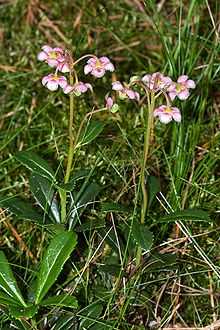Chimaphila umbellata
| Chimaphila umbellata | |
|---|---|
 | |
| Conservation status | |
| Scientific classification | |
| Kingdom: | Plantae |
| (unranked): | Angiosperms |
| (unranked): | Eudicots |
| (unranked): | Asterids |
| Order: | Ericales |
| Family: | Ericaceae |
| Genus: | Chimaphila |
| Species: | C. umbellata |
| Binomial name | |
| Chimaphila umbellata (L.) Barton | |
Chimaphila umbellata (Umbellate Wintergreen, Pipsissewa, or Prince's pine) is a small perennial flowering plant found in dry woodlands, or sandy soils. It is native throughout the cool temperate Northern Hemisphere.
It grows 10–35 cm tall, and has evergreen shiny, bright green, toothed leaves arranged in opposite pairs or whorls of 3-4 along the stem. Leaves have a shallowly toothed margin, where the teeth have fine hairs at their ends. The flowers are white or pink, produced in a small umbel of 4-8 together.
Ecology
Although it has green leaves year-round, it receives a significant portion of its nutrition from fungi in the soil (that is, it is a partial myco-heterotroph, which is not surprising as related plants, such as Pyrola, are partial or full myco-heterotrophs).[1]
Taxonomy
There are four subspecies:
- Chimaphila umbellata subsp. umbellata – Europe, Asia
- Chimaphila umbellata subsp. acuta – southwestern North America
- Chimaphila umbellata subsp. cisatlantica – northeastern North America
- Chimaphila umbellata subsp. occidentalis – northwestern North America
Uses
Some Plateau Indian tribes used a boil of prince's pine to treat tuberculosis.[2]
It is used as a flavoring in candy and soft drinks, particularly root beer.
"Pipsissewa" is a Cree name meaning "It-breaks-into-small-pieces".
| Wikimedia Commons has media related to Chimaphila umbellata. |
References
- ↑ Leho Tedersoo, Prune Pellet, Urmas Kõljalg and Marc-André Selosse (March 2007). "Parallel evolutionary paths to mycoheterotrophy in understorey Ericaceae and Orchidaceae: ecological evidence for mixotrophy in Pyroleae". Oecologia 151 (2): 206–217. doi:10.1007/s00442-006-0581-2. PMID 17089139.
- ↑ Hunn, Eugene S. (1990). Nch'i-Wana, "The Big River": Mid-Columbia Indians and Their Land. University of Washington Press. p. 352. ISBN 0-295-97119-3.
External links
- Flora of China: Chimaphila umbellata
- Flora Europaea: Chimaphila umbellata distribution
- linnaeus.nrm.se: Range map with the different subspecies of the Chimaphila umbellata-complex
- Jepson Manual treatment - Chimaphila umbellata
- USDA Plant Profile for Chimaphila umbellata (pipsissewa)
- Germplasm Resources Information Network: Chimaphila umbellata
- USDA Forest Service: Chimaphila umbellata
